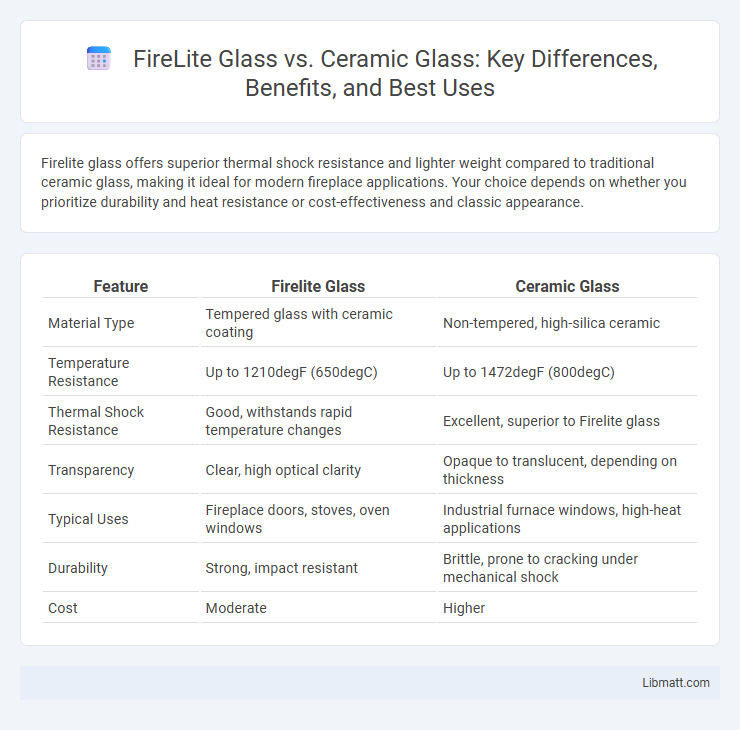Firelite glass offers superior thermal shock resistance and lighter weight compared to traditional ceramic glass, making it ideal for modern fireplace applications. Your choice depends on whether you prioritize durability and heat resistance or cost-effectiveness and classic appearance.
Table of Comparison
| Feature | Firelite Glass | Ceramic Glass |
|---|---|---|
| Material Type | Tempered glass with ceramic coating | Non-tempered, high-silica ceramic |
| Temperature Resistance | Up to 1210degF (650degC) | Up to 1472degF (800degC) |
| Thermal Shock Resistance | Good, withstands rapid temperature changes | Excellent, superior to Firelite glass |
| Transparency | Clear, high optical clarity | Opaque to translucent, depending on thickness |
| Typical Uses | Fireplace doors, stoves, oven windows | Industrial furnace windows, high-heat applications |
| Durability | Strong, impact resistant | Brittle, prone to cracking under mechanical shock |
| Cost | Moderate | Higher |
Introduction to Firelite Glass and Ceramic Glass
Firelite glass, a chemically strengthened toughened glass, offers superior thermal shock resistance and durability compared to traditional ceramic glass used in ovens and fireplaces. Ceramic glass, known for its excellent heat insulation and ability to withstand extremely high temperatures, is often favored for use in high-heat environments but is more brittle than Firelite. The choice between Firelite and ceramic glass depends on specific performance requirements such as thermal resistance, impact strength, and longevity in thermal cycling conditions.
Composition and Material Differences
Firelite glass is an engineered soda-lime glass mixed with proprietary additives that enhance its thermal stability and resistance to thermal shock. Ceramic glass, typically made from glass-ceramic composites like lithium aluminosilicate, exhibits superior heat resistance and structural integrity under extreme temperatures. The key material difference lies in Firelite's enhanced soda-lime base versus the crystalline microstructure of ceramic glass, impacting their thermal and mechanical performance.
Thermal Performance and Heat Resistance
Firelite glass offers superior thermal performance with high resistance to thermal shock, enabling it to withstand rapid temperature changes up to 650degF without cracking. Ceramic glass excels in heat resistance, tolerating continuous exposure to temperatures above 1,200degF, making it ideal for high-heat applications such as fireplace doors and stove windows. While Firelite glass provides enhanced durability against sudden heat spikes, ceramic glass ensures long-term stability under intense, consistent heat conditions.
Fire Safety Ratings and Certifications
Firelite glass offers superior fire safety ratings compared to traditional ceramic glass, often meeting or exceeding ASTM E119 and UL 9 fire testing standards. This enhanced performance ensures that Firelite glass can withstand higher temperatures and provide longer fire protection, making it ideal for fire-rated architectural applications. You can rely on Firelite glass for certified fire resistance that maintains both safety and transparency in your building projects.
Applications in Residential and Commercial Settings
Firelite glass offers superior impact resistance and thermal stability, making it ideal for commercial settings such as storefronts, banks, and airports where high durability and security are essential. Ceramic glass, known for its exceptional heat resistance and insulating properties, is preferred in residential applications like fireplace doors and stovetops to withstand direct flame and high temperatures. Selecting the right material for your project depends on whether impact strength or heat resistance is the primary requirement.
Optical Clarity and Aesthetics
Firelite glass offers superior optical clarity with minimal distortion, enhancing your view of flames and creating a more realistic and vibrant fire experience. Ceramic glass maintains excellent heat resistance but can exhibit slight haze or reflections, which may reduce visual sharpness compared to Firelite. Choosing Firelite glass improves aesthetics by providing a crystal-clear window that elevates the overall ambiance of your fireplace.
Installation Considerations
Firelite glass requires careful handling during installation due to its thicker and heavier composition compared to ceramic glass, necessitating stronger framing and support structures. Ceramic glass, being lighter and thinner, offers easier installation with standard frames but may require precise fitting to prevent thermal stress and cracking. Choosing the right glass depends on your project's structural capacity and safety requirements, with Firelite glass providing enhanced durability in demanding environments.
Durability and Longevity
Firelite glass exhibits exceptional durability due to its high thermal shock resistance and ability to withstand rapid temperature changes, making it ideal for fireplace doors and stove windows. Ceramic glass offers superior longevity by maintaining structural integrity even under prolonged exposure to extreme heat, reducing the risk of cracking or discoloration over time. Both materials outperform standard glass in heat resistance, but ceramic glass generally provides longer-lasting performance in continuous high-temperature environments.
Cost Comparison and Value
Firelite glass typically costs more than ceramic glass due to its advanced durability and heat resistance properties, making it suitable for high-temperature applications. Ceramic glass offers a more affordable option with good thermal stability but lower impact resistance compared to Firelite. Investing in Firelite glass ensures long-term value through enhanced safety and longevity, while ceramic glass serves well for budget-conscious projects with moderate heat exposure.
Choosing the Right Glass for Your Project
Firelite glass offers superior thermal shock resistance and impact durability, making it ideal for high-temperature applications and safety installations. Ceramic glass withstands extreme heat and thermal cycling, commonly used in ovens and fireplaces for its stability and longevity. Selecting between Firelite and ceramic glass depends on project requirements such as temperature tolerance, mechanical strength, and safety standards.
Firelite glass vs ceramic glass Infographic

 libmatt.com
libmatt.com